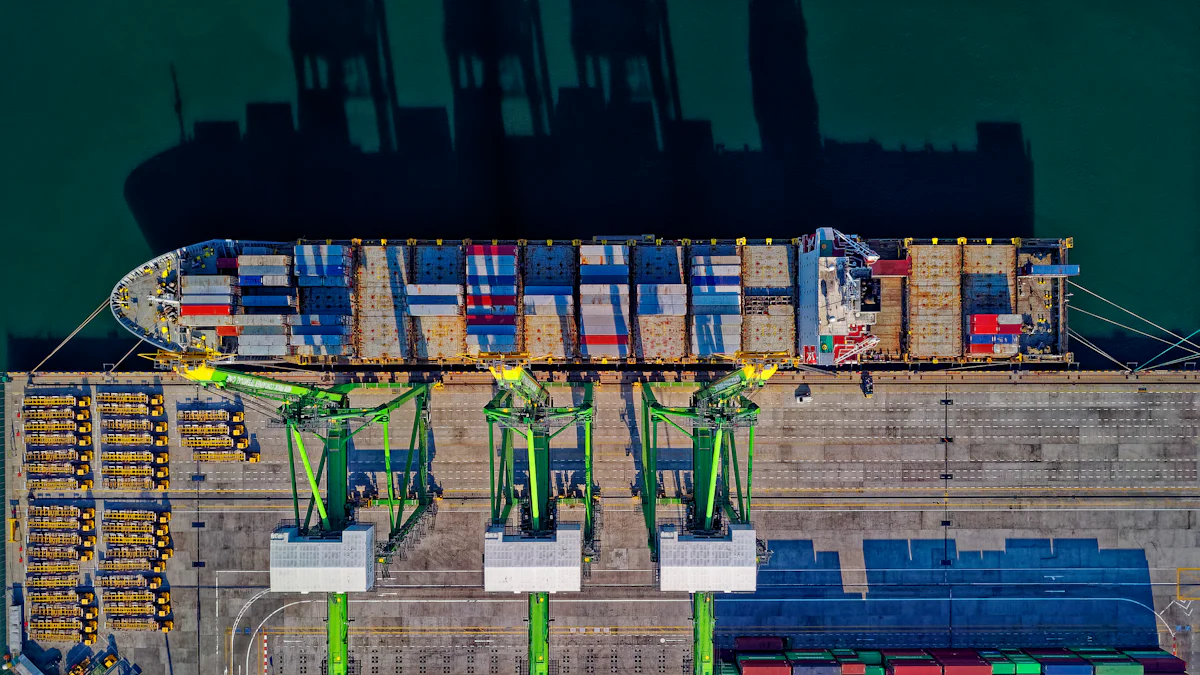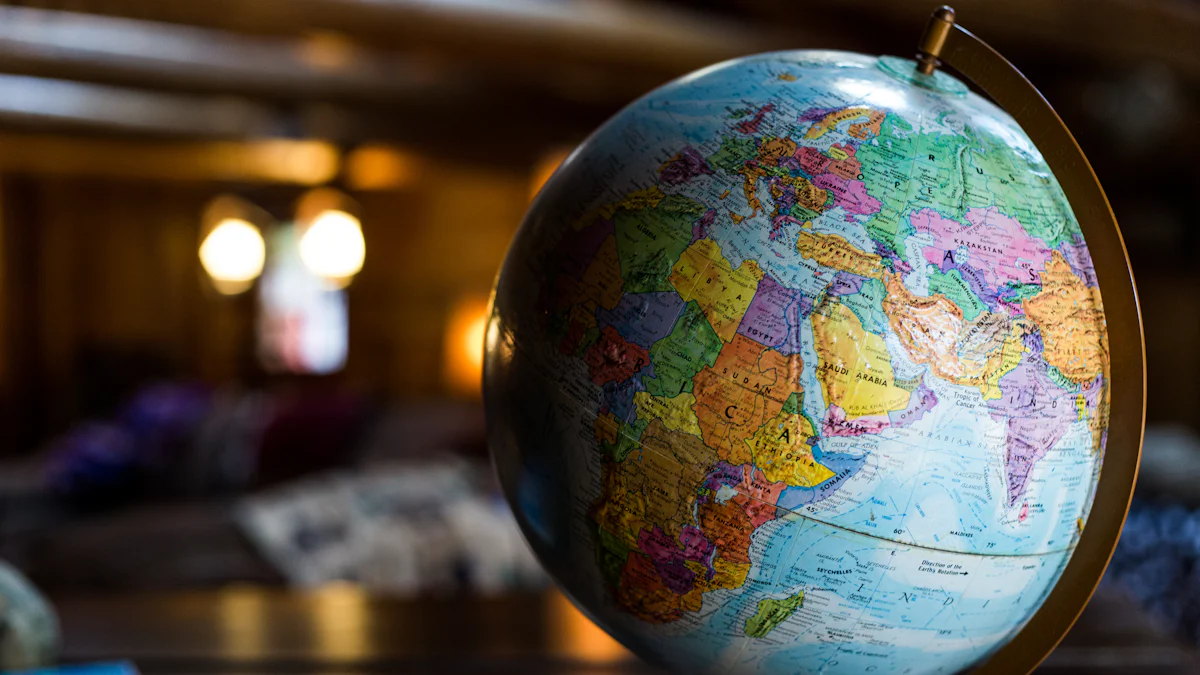The Future of Global Trade Amid Geopolitical Tensions in 2025

Global trade serves as the backbone of the interconnected world, driving economic growth and innovation. However, geopolitical tensions increasingly disrupt these connections, altering trade patterns. For instance, trade between rivals has declined by 4% since 2018, while aligned nations saw a 6% rise. The table below illustrates how geopolitical shifts influence trade volumes:
Geopolitical Change | Impact on Trade |
|---|---|
10% increase in geopolitical distance | 2% decrease in bilateral trade flows |
Trade between aligned countries (2018–2023) | 6% increase compared to 2012–2017 |
Trade between rivals (2018–2023) |
Businesses and governments must act swiftly to adapt to these evolving global trade dynamics, ensuring resilience in an unpredictable landscape.
Key Takeaways
Political conflicts are changing how countries trade. Companies need to adjust fast to stay ahead.
Spreading out supply chains is very important. Big companies like Apple and Huawei show why sharing risks across areas matters.
New markets in Africa and Asia offer chances to grow. Businesses should look into these places to grow bigger.
Geopolitical Forces Shaping Global Trade Dynamics

U.S.-China Relations and Their Impact on Global Trade
The competition between the United States and China continues to shape global trade dynamics. U.S. policymakers have raised concerns about Chinese disinformation campaigns and espionage activities. They fear that Chinese technology could compromise national security. Additionally, accusations of intellectual property theft and forced technology transfers have strained relations further. On the other hand, China's heavy subsidies for industries like renewable energy have disrupted market competition. These subsidies create challenges for foreign companies unable to match such state support. Human rights issues, including forced labor in Xinjiang, have also influenced trade policies. Retaliatory tariffs between the two nations have led to significant economic losses. For example, U.S. export losses totaled $27 billion between 2018 and 2019. Reversing these tariffs could boost U.S. output by 4% over three years, underscoring the long-term impact of these trade restrictions.
The Rise of Protectionism in a Divided World
Protectionist policies have become more prevalent as nations prioritize domestic industries. While global trade remains resilient, protectionism has disrupted certain sectors. For instance, U.S. agricultural producers struggled to find alternative markets when China shifted its purchases. This shift highlights the unintended consequences of protectionist measures. Despite these challenges, global value chains accounted for 52% of trade in 2022, reflecting ongoing interdependence. However, naïve trade policies can threaten food security. A 1% drop in global harvests could increase food prices by 8.5%, emphasizing the need for balanced trade strategies.
Regional Conflicts and Trade Route Disruptions
Regional conflicts have significantly impacted global trade. The Red Sea crisis, marked by Houthi attacks on shipping, has disrupted a critical trade route. These attacks have increased shipping costs and forced companies to reroute vessels around the Cape of Good Hope. This diversion adds 10 to 12 days to transit times, raising operational costs. The crisis has also caused a 243% increase in shipping costs from East Asia to North Europe. Such disruptions mirror the supply chain challenges experienced during the COVID-19 pandemic, highlighting the fragility of global trade routes.
Multilateral Trade Agreements Amid Geopolitical Tensions
Amid rising geopolitical tensions, multilateral trade agreements have gained importance. The World Trade Organization recently negotiated agreements on fisheries and COVID-19 vaccine intellectual property rights. The fisheries agreement aims to reduce harmful subsidies, marking a significant step in global trade cooperation. Similarly, the partial waiver of vaccine intellectual property rights reflects efforts to balance global health needs with trade regulations. These agreements demonstrate the potential for collaboration, even in a fragmented geopolitical landscape.
Economic and Technological Trends Reshaping Global Trade

Supply Chain Restructuring and Nearshoring Strategies
Supply chains are undergoing a significant transformation as businesses adapt to a new geoeconomic reality. Rising shipping costs and tariffs have driven companies to restructure their supply chains, prioritizing nearshoring strategies. This approach offers several advantages:
Cost savings through reduced transportation expenses.
Enhanced supply chain resilience by minimizing reliance on distant suppliers.
Faster response times to market changes, particularly in industries with rapid trends.
Industries such as automotive, mechanical engineering, and medical technology have embraced nearshoring. In Europe, 47% of buyers increased nearshoring activities in the past year, while 31% combined nearshoring with reshoring. These strategies not only reduce lead times but also align with environmental, social, and governance (ESG) standards by sourcing locally.
The Role of Digital Trade in Modern Global Trade Dynamics
Digital trade technologies are revolutionizing global trade practices. Blockchain and electronic customs documentation enhance compliance and transparency, reducing costs and inefficiencies. Intangible assets, such as intellectual property, now account for 13.1% of global revenue, reflecting a shift toward digital trade. Micro, small, and medium-sized enterprises (MSMEs) particularly benefit from these advancements. In Mexico, where 97.3% of firms are MSMEs, access to robust digital infrastructure enables participation in international trade, opening new markets and opportunities.
The Green Agenda and Its Influence on Trade Policies
The global green agenda is reshaping trade policies, emphasizing decarbonization and clean-energy transitions. Geopolitical challenges, such as Russia’s invasion of Ukraine, have heightened the urgency for energy independence. Countries are adopting renewable energy sources to maintain economic competitiveness. The demand for critical minerals essential for sustainable technologies is also rising, creating new dependencies on resource-rich nations. These shifts are altering global trade dynamics, requiring businesses to adapt to evolving environmental standards.
Emerging Markets and Their Growing Role in Global Trade
Emerging markets are poised to play a pivotal role in global trade by 2025. Africa’s exports are projected to grow faster than any other region, with its GDP surpassing all others at market exchange rates. China continues to stimulate its economy through aggressive financial measures, boosting trade growth in East Asia. India is also gaining prominence, leveraging its expanding industrial base. These markets are reshaping global trade patterns, offering new opportunities for businesses navigating complex international supply chains.
Navigating Global Trade Challenges: Insights for Businesses and Governments
Strategies for Businesses to Mitigate Geopolitical Risks
Businesses must adopt proactive measures to navigate the complexities of the global trade environment. Scenario planning enables companies to prepare for uncertainties and mitigate risks effectively. Defining a clear geopolitical risk appetite helps guide decision-making and risk management strategies. Early engagement with policymakers allows businesses to influence trade-related decisions constructively. Collaboration with industry peers fosters stability and reduces risks. Trade diversification strategies also play a crucial role. For example, Apple diversified its supply chain across multiple countries to reduce reliance on a single region, mitigating the impact of the US-China trade war. Similarly, Huawei expanded its software services to counter restrictions on hardware sales. These approaches demonstrate the importance of adaptability in a volatile trade landscape.
Policy Recommendations for Governments to Foster Resilient Trade
Governments must adopt comprehensive policies to address trade challenges. Clear communication of geopolitical objectives ensures businesses can align their strategies effectively. Reassessing the effectiveness of sanctions in a multipolar world is essential to avoid unintended consequences. A coherent sanctions regime prevents conflicting measures that could disrupt trade. Governments should offset the economic burdens of punitive measures by supporting affected industries. Developing updated guidelines for responsible business conduct helps multinationals navigate complex geopolitical realities. These measures strengthen regional alliances and promote a stable global trade environment.
Leveraging Technology to Overcome Trade Barriers
Technological innovations are transforming global trade operations. Blockchain technology enhances supply chain transparency, as demonstrated by Grupo Sol, which secured partnerships with environmentally conscious clients by verifying sustainable practices. Artificial intelligence optimizes logistics, predicts disruptions, and automates compliance processes. AI-driven tools like those used by Amazon improve inventory management and logistics efficiency. These advancements enable businesses to overcome trade barriers, reduce costs, and enhance operational efficiency.
The Role of JUSDA in Enhancing Supply Chain Efficiency
JUSDA plays a pivotal role in streamlining supply chain operations amid geopolitical tensions. Its JusTrade platform simplifies customs clearance through AI-powered solutions, ensuring compliance and reducing delays. The platform integrates seamlessly with clients' systems, providing real-time tracking and analytics. By leveraging advanced technologies, JUSDA enhances supply chain visibility and efficiency. Its tailored solutions empower businesses to navigate cross-border trade challenges, optimize costs, and maintain operational continuity. JUSDA's commitment to innovation positions it as a leader in global supply chain management.
JusTrade: Simplifying Customs Clearance in a Complex Geopolitical Landscape
Intelligent Customs Solutions for Global Trade
JusTrade offers intelligent customs solutions that address the complexities of modern trade. Its proprietary SAAS platform integrates advanced AI algorithms and big data analytics to streamline customs clearance processes. This technology enables businesses to classify commodities accurately, process bonded trade efficiently, and manage cross-border logistics seamlessly. JusTrade’s solutions reduce manual errors and enhance compliance, ensuring smooth operations across diverse markets. By leveraging its expertise, JusTrade empowers businesses to navigate the intricate customs landscape with precision and speed.
Enhancing Trade Compliance Through JusTrade’s SAAS Platform
JusTrade’s SAAS platform revolutionizes trade compliance by providing real-time data integration and analytics. The platform connects procurement, logistics, customs, and finance departments, creating a unified system for managing customs operations. Its intelligent interface supports multiple languages and currencies, catering to global clients. Features like automated documentation and compliance tracking ensure adherence to international regulations. This approach minimizes delays and penalties, allowing businesses to focus on expanding their trade networks.
Supporting Businesses in Navigating Cross-Border Trade Challenges
Cross-border trade often involves navigating complex regulations and logistical hurdles. JusTrade simplifies this process through tailored solutions that address specific industry needs. Its services include bonded zone expressways, China-Hong Kong border crossings, and vehicle self-registration systems. These innovations reduce transit times and operational costs, enabling businesses to maintain uninterrupted production. JusTrade’s expertise in customs brokerage and freight forwarding ensures that clients can overcome cross-border challenges effectively.
JusTrade’s Role in Streamlining Global Trade Operations
JusTrade plays a pivotal role in optimizing global trade operations. Its end-to-end customs solutions integrate seamlessly with clients’ supply chains, enhancing visibility and efficiency. The platform’s real-time tracking capabilities provide businesses with actionable insights, improving decision-making and operational planning. By reducing bottlenecks and ensuring compliance, JusTrade helps companies achieve cost savings and maintain competitive advantages. Its commitment to innovation and excellence positions it as a leader in the global trade ecosystem.

JUSDA Solutions
To provide you with professional solutions and quotations.
Global trade in 2025 faces challenges from conflicts disrupting routes, rising protectionism, and regional trade blocs. Businesses must diversify supply chains, adapt to regulations, and engage policymakers. Governments should foster alliances and leverage data-driven strategies. Emerging markets and green initiatives offer opportunities, but resilience and collaboration remain critical for navigating this evolving landscape.
See Also
Exploring How Global Trade Policies Shape Economies
Five Key Trends Driving Future Supply Chain Efficiency
Addressing Global Supply Chain Expansion Challenges Effectively
